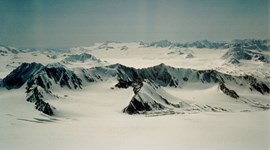|
The Harding Icefield and its outflowing glaciers cover 700 square miles of Alaska's Kenai Mountains in glacier ice. Created more than 23,000 years ago during the Pleistocene Epoch, the Harding Icefield was a small piece of the vast ice sheet that covered much of Southcentral Alaska (Figure 1). Indeed, at the time, ice blanketed one third of the Earth's surface.

esti NPS photo Naming the Ice Over 30 glaciers of different size and type flow outward from the Harding Icefield. Some of these glaciers are tidewater (Aialik Glacier) or terminate in lakes (Skilak Glacier), and some end on land (Exit Glacier). Icefields are sensitive to climate change, growing and melting in response to changes in temperature and snowfall. Icefields also exert their own influence on local and global climate, changing pressure systems and wind directions, serving to keep adjacent land and water cold.
Climate Change Past and Present A National Park Service (NPS) study using aerial photographs and satellite imagery measured a three percent reduction in the surface area of the Harding Icefield over a period of 16 years. The NPS plans to repeat this study every ten years to monitor further changes. In 2004, the NPS installed an automated weather station at 4,200 feet on a nunatak in the northeastern part of the Harding Icefield (Figure 2). The weather station records and transmits weather observations (temperature, wind speed and direction, relative humidity, precipitation, snow depth, and solar radiation) hourly. Current weather observations and summary reports can be viewed at the Western Region Climate Center’s website: http://www.wrcc.dri.edu/cgi-bin/ rawMAIN.pl?akAHAR During the first three full years of operation, the lowest observed temperature was -21 degrees F, the highest observed temperature was 68 degrees F, and the maximum observed sustained wind gust was 117 miles per hour.
The Lure of the Icefield Before the early 1920s, local residents paid little attention to the huge icefield in the mountain range behind the town. Alutiiq and Dena’ina Natives were no doubt familiar with the ice and had accessed it, but there is no record of any attempted crossing until 1936. Yule Kilcher, a 27-year-old Swiss immigrant, had heard of the icefield and seen its edge from the steamer that had dropped him off in Seward. Needing to get to Homer and unwilling to wait for another steamer, Kilcher decided to cross the Harding. He headed up Lowell Creek but returned within a week, having learned a crossing like this would be more of an expedition than a hike. The first known crossing of the icefield occurred in 1940 when two Alaskans, Eugene “Coho” Smith and Don Rising, crossed from Bear Glacier to Tustumena Lake. In the mid-1960s, two parties attempted but failed to make the crossing. In 1968, a mountaineering party departed Homer on horseback, traveled up Chernof Glacier on foot and skis, and completed the first ascent of Truuli Peak, the highest point on the Kenai Peninsula. Part of this group, including Yule Kilcher, continued across the Harding Icefield and skied down Exit Glacier. The trip took eight days. Notable recent explorations include a 14-hour solo crossing of the icefield from Skilak Glacier to Chernof Glacier and a kite-skiing expedition from Exit Glacier to Grewingk Glacier.
Ice as Far as the Eye Can See |
Last updated: April 14, 2015
